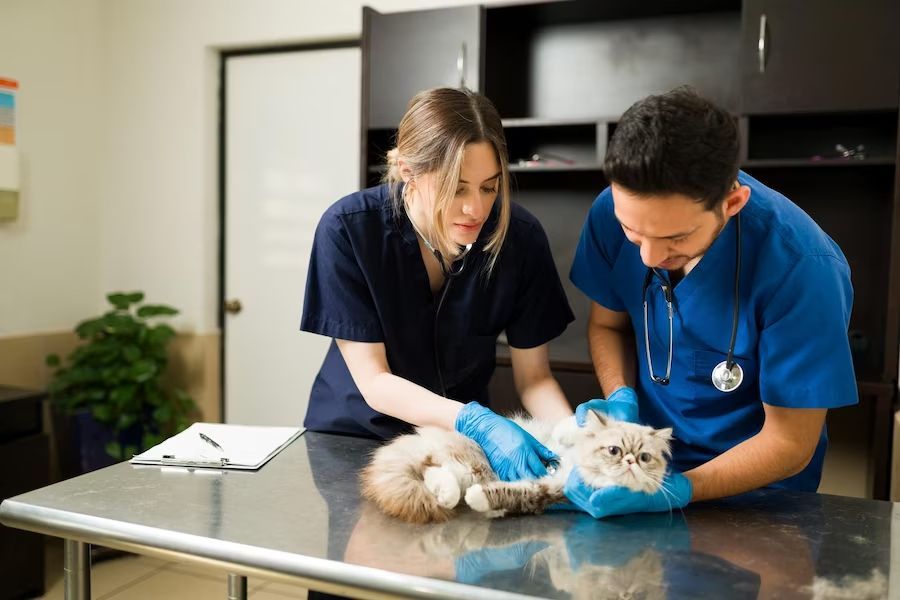What are Dog Ear Mites?
Have you ever heard of ear mites? Has your dog been diagnosed with ear mites, or has your vet told you to be on the lookout for this potential problem in your pet? If any of this sounds like your situation, then you’re probably wondering what ear mites really are.
In the article below, we’ll break down the basic information you need to know about dog ear mites. You can use this information to better understand your dog’s condition, treatment recommendations, and more. Be sure to work with your vet to treat this condition.
What is an Ear Mite?
A mite is a type of parasite that is similar to a tick. However, unlike ticks, mites don’t bury up under the skin. Instead, they bite and live on the surface of the skin. They live on host animals and tend to stay in dark places on the animal’s body. Therefore, the ear canal is the ideal location for ear mites.
If your dog has ear mites, you may not see them at all. Many ear mites are so small that they cannot be seen without the help of a microscope, unless your dog has very pink or white inner ears. As the infestations worsen, they may become more visible and may spread from within the ear canal up to the outer parts of the ear. This is typically the point at which pet owners notice there is something wrong. Ear mites are extremely common in both dogs and cats.
What are the Symptoms?
The main symptoms of this condition are listed below:
Head Shaking
Head shaking occurs in dogs who have any type of ear irritation. It can also be a sign of ear infection, so it’s important to take your pet to the vet to rule out this risk if you suspect ear mites.
Ear Discharge
Ear discharge may look like wax, or it may be crusty and dark. This type of discharge is common with ear mites. If your dog’s ear discharge looks more like pus, this is indicative of an ear infection.
Ear Pawing
Ear pawing happens when your dog’s ear feels uncomfortable. Too much pawing and scratching can cause an abscess on the ear, especially if the skin is broken.
What are Some Risk Factors this Condition?
Listed below are the main risk factors:
Contact With Another Animal
The biggest contributing factor in ear mite infestations is contact with another animal that already has ear mites. If one of your pets has mites, others are likely to contract an infestation, too.
Outdoor Activity
Dogs who spend a lot of time outside, especially in the woods or in tall grass, are more likely to have ear mites.
Floppy Ears
Floppy ears make dogs slightly more prone to ear mites, but any type of dog can have this problem.
Young Age
Mites are slightly more common in younger dogs and puppies than in older dogs. However, the difference is a small one, and dogs of any age can have mites.
How Can You Treat Ear Mites in Dogs?
Listed below are treatment methods:
Ear Drops and Gels
Ear drops, gels, and other topical ear medication are the most common treatment for ear mites. They are typically intended to be placed in the pet’s ears, then used for cleaning mites out of the ears as well. Your vet can give you specifics on how to use drops for your dog.
Injection Medication
Injections may sometimes be given to help your dog fight ear mites.
Antibiotics
Antibiotics will not get rid of ear mites in your dog. However, they may be prescribed to prevent your pet from getting a secondary infection. They may also be given if your dog has an abscess on her ear from scratching.
How Can you Prevent This?
Tips to prevent this:
Wash and Dry Your Pet’s Laundry
Keep your pet’s blankets, pillows, and bedding clean. Even if your pet has not yet had ear mites, regular cleaning is crucial.
Wash Your Dog’s Ears
During regular bath time, use a dog-safe ear cleaner to clean out the inside of your pet’s ears.
Keep Your Dog Away From Those With Ear Mites
If you know or suspect another dog or animal you know has ear mites, keep your pet away from that animal for the foreseeable future.
Contact 24/7 Local Veterinarian if Your Dogs Has Ear Mites
Based on this guide, you can form a better understanding of ear mites in your pet. Refer back to this information if your dog is dealing with ear mites or if you just want to know how to protect your pet from these parasites.
Your vet can give you more specific information about your pet’s individual health needs. Talk to your vet if you have any questions or concerns about your dog’s ear health, if you suspect she may have ear mites, or if you don’t feel like her current ear mite treatment is working well enough.
Contact 24/7 Local Veterinarian f you are concerned about your cat not eating. We have locations all over the country with emergency vets who are available 24/7 to help you and your pet. When you come to a 24/7 Local Veterinarian, our team will get to the cause of your dog’s ear mites and you can rest assured that your pet will get the proper care they need.
Contact with your local vet for the best advise
Resource Center









